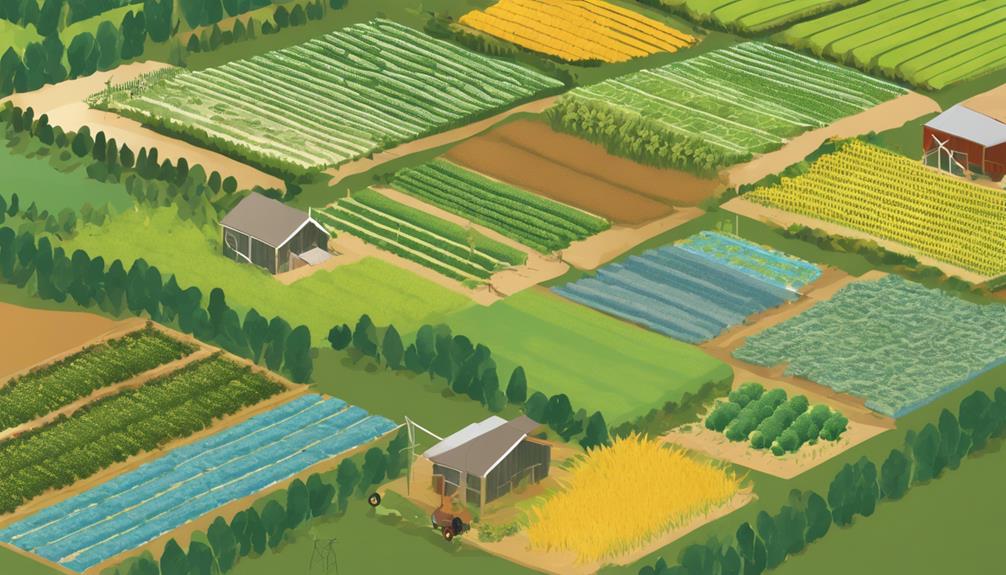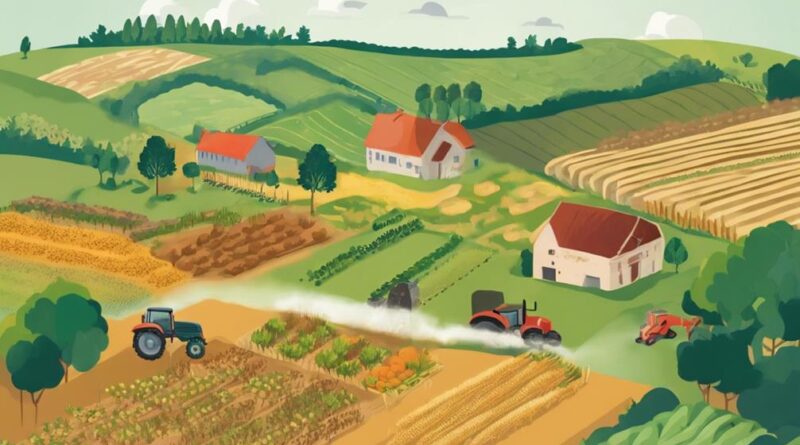Three Key Ways Agriculture Battles Climate Change
Enhance soil health through organic farming to sequester carbon and reduce emissions. Conserve biodiversity to foster resilient agricultural systems. Increase water efficiency with innovative irrigation techniques. Agriculture battles climate change by improving soil, preserving ecosystems, and optimizing water usage. Discover more ways agriculture combats climate change by exploring organic practices, biodiversity conservation, and water conservation strategies.
Importance of Organic Farming
In the battle against climate change, organic farming stands out as a proven method to reduce carbon emissions and enhance soil health. Organic farming practices prioritize the use of natural fertilizers such as compost and manure, which not only improve soil fertility but also contribute to lower carbon emissions compared to conventional farming methods. Studies have shown that organic farming has the potential to reduce the carbon footprint of agriculture by sequestering carbon in the soil and decreasing the reliance on synthetic fertilizers that are energy-intensive to produce.
By focusing on building healthy soils rich in organic matter, organic farming enhances soil fertility, promotes biodiversity, and improves water retention capacity. These factors not only benefit crop productivity but also play a significant role in carbon sequestration. Organic farming practices such as crop rotation, intercropping, and the use of cover crops help sequester carbon dioxide from the atmosphere into the soil, thereby mitigating climate change impacts.
Transitioning to organic farming presents a tangible solution for reducing the carbon footprint of agriculture while simultaneously promoting sustainable land management practices. By adopting organic farming methods, you can actively contribute to combating climate change while ensuring long-term soil health and productivity.
Carbon Sequestration in Soil
Enhancing soil's capacity to capture and store carbon is a critical strategy in mitigating the impacts of climate change. Soil carbon sequestration plays a vital role in sustainable agriculture practices, offering a tangible solution to combat rising carbon levels in the atmosphere. By implementing specific techniques such as cover cropping, no-till farming, and agroforestry, farmers can significantly increase the amount of carbon stored in the soil.
Studies have shown that sustainable agricultural practices can help sequester carbon in the soil. For example, a research study conducted by the University of California, Davis, found that no-till farming practices can increase soil organic carbon levels by up to 15% over 30 years. This demonstrates the potential of sustainable agriculture to not only improve soil health but also contribute to climate change mitigation efforts.
Furthermore, adopting regenerative agricultural practices can enhance soil carbon sequestration. By incorporating diverse crop rotations, minimizing soil disturbance, and integrating livestock into cropping systems, farmers can build organic matter in the soil, thus trapping more carbon over time. These innovative approaches not only benefit the environment but also promote long-term agricultural sustainability. In conclusion, prioritizing soil carbon sequestration through sustainable agriculture practices is a tangible and effective way to combat climate change.
Reduced Greenhouse Gas Emissions
To reduce greenhouse gas emissions significantly, agricultural practices must prioritize innovative techniques and sustainable solutions. Soil management plays a crucial role in this endeavor. Implementing practices such as reduced tillage, cover cropping, and organic amendments can enhance soil health and sequester carbon effectively. By enriching the soil with organic matter, you can promote the growth of beneficial microorganisms that help convert atmospheric carbon into stable organic forms, thus reducing greenhouse gas levels.
Crop rotation is another powerful tool in reducing emissions. Rotating crops can break pest cycles, improve soil structure, and increase nutrient availability, all of which contribute to lower greenhouse gas emissions. Different crops have varying effects on soil health and carbon sequestration, and by diversifying crop rotations, you can maximize these benefits. For example, leguminous crops like peas and beans have the added advantage of fixing atmospheric nitrogen into the soil, reducing the need for synthetic fertilizers that contribute to greenhouse gas emissions.
Biodiversity Conservation Efforts
Implementing biodiversity conservation efforts in agricultural practices is crucial for enhancing ecosystem resilience and promoting sustainable food production. By incorporating wildlife preservation and agroforestry techniques, agriculture can play a significant role in combating climate change while fostering biodiversity.
Here are three key ways biodiversity conservation efforts contribute to a more sustainable agricultural system:
- Wildlife Preservation: Integrating wildlife preservation strategies within agricultural landscapes helps maintain biodiversity by providing habitats for various species. This not only supports the overall health of ecosystems but also enhances natural pest control and pollination, ultimately leading to more resilient and productive agricultural systems.
- Agroforestry: Implementing agroforestry practices, which involve integrating trees and shrubs into agricultural land, promotes biodiversity by creating diverse habitats for wildlife. Agroforestry systems also contribute to sustainable agriculture by improving soil health, conserving water, and sequestering carbon, making them a valuable tool in mitigating climate change.
- Habitat Restoration: Engaging in habitat restoration efforts within agricultural areas helps revive ecosystems that may have been degraded due to intensive farming practices. By restoring natural habitats and creating corridors for wildlife movement, agricultural lands can support biodiversity while enhancing ecosystem services and resilience in the face of a changing climate.
Water Conservation Practices
Conserving water in agricultural practices is a critical component of sustainable farming methods aimed at addressing climate change and promoting efficient resource utilization. By implementing irrigation efficiency techniques, farmers can significantly reduce water wastage and enhance crop yields. Efficient irrigation systems such as drip irrigation and sprinkler systems deliver water directly to the roots of plants, minimizing evaporation and runoff. This approach not only conserves water but also ensures that crops receive an adequate supply for optimal growth.
Crop rotation practices play a crucial role in water conservation efforts. Rotating different crops seasonally helps improve soil health, reduce water usage, and prevent waterborne diseases. Certain crops have deep roots that can access groundwater more effectively, reducing the need for excessive irrigation. Additionally, rotating crops with varying water needs can help balance water usage across different fields, preventing water depletion in specific areas.
Innovative technologies, such as soil moisture sensors and weather forecasting tools, enable farmers to make data-driven decisions regarding irrigation scheduling. These tools provide real-time information on soil moisture levels and weather patterns, allowing farmers to adjust their irrigation practices accordingly. By combining irrigation efficiency methods with strategic crop rotation practices and cutting-edge technologies, agriculture can make significant strides in water conservation, contributing to a more sustainable and climate-resilient future.
Enhanced Soil Health Benefits
Enhancing soil health offers a myriad of benefits for agricultural productivity and environmental sustainability through promoting nutrient-rich ecosystems and fostering resilient crop growth. When focusing on soil health, you aren't only investing in the future of your farm but also contributing to the fight against climate change. Here are three key ways enhancing soil health benefits agriculture:
- Improved Soil Fertility: By enhancing soil health, you're enriching the soil with essential nutrients that are vital for plant growth. Healthy soils with high fertility levels can support robust crop development, leading to higher yields and better quality produce.
- Enhanced Microbial Activity: Healthy soils are teeming with diverse microbial life that plays a crucial role in nutrient cycling and plant health. By promoting microbial activity through practices like crop rotation and organic amendments, you can create a thriving ecosystem underground that supports plant growth and resilience.
- Increased Carbon Sequestration: Healthy soils act as a carbon sink, storing significant amounts of carbon underground. By enhancing soil health and promoting practices that increase organic matter content, you can help mitigate climate change by sequestering carbon dioxide from the atmosphere into the soil.
Investing in soil health isn't just beneficial for your farm's productivity; it's a powerful tool in the fight against climate change. Prioritizing soil health through sustainable practices can lead to long-term benefits for both agriculture and the environment.
Resilience to Climate Extremes

Boosting crop resilience to climate extremes requires strategic planning and adaptive management practices to safeguard agricultural productivity in the face of changing environmental conditions. One key strategy is crop diversification, which involves planting a variety of crops to spread risk and enhance overall resilience. By diversifying crops, farmers can reduce the impact of extreme weather events such as droughts, floods, or heatwaves on their overall production. This approach not only helps mitigate the effects of climate change but also contributes to maintaining stable yields and secure food systems.
Weather adaptation plays a crucial role in enhancing resilience to climate extremes. Farmers can implement practices such as improved irrigation systems, water management techniques, and planting schedules adjusted to changing weather patterns. By adopting these adaptive measures, farmers can better cope with unpredictable weather conditions and minimize potential crop losses. Additionally, investing in climate-resilient crop varieties that are better suited to withstand extreme temperatures, pests, or diseases can further enhance agricultural resilience.
Economic Viability of Organic Practices
To ensure the economic viability of organic practices in agriculture, farmers must carefully assess the cost-effectiveness and long-term sustainability of transitioning to organic production methods. Organic farming has gained momentum due to consumer demand for healthier and environmentally friendly products. Here are three key factors to consider when evaluating the economic viability of organic practices:
- Market Demand: Understanding consumer preferences and market trends is crucial for the economic success of organic farming. By aligning production with market demand, farmers can ensure a steady flow of income and potentially premium prices for their organic products. Market research and staying informed about changing consumer preferences can help farmers make informed decisions about which organic products to cultivate.
- Cost Effectiveness: While transitioning to organic practices may involve initial investments and changes in farming techniques, assessing the long-term cost-effectiveness is essential. Organic farming methods can lead to reduced input costs over time, such as lower expenses on synthetic pesticides and fertilizers. Moreover, organic farming practices like crop rotation and composting can improve soil health, leading to sustainable agricultural productivity in the long run.
- Innovative Marketing Strategies: Developing innovative marketing strategies can help farmers differentiate their organic products in a competitive market. Direct-to-consumer sales, organic certification, and labeling practices can add value to organic products and attract environmentally conscious consumers willing to pay a premium for organic produce. By embracing digital platforms and engaging with consumers through storytelling, farmers can build brand loyalty and increase the economic viability of their organic practices.
Conclusion
In conclusion, agriculture plays a crucial role in combating climate change through organic farming, carbon sequestration, and greenhouse gas reduction.
By implementing sustainable practices, such as biodiversity conservation and water conservation, farmers can enhance soil health and resilience to climate extremes.
These efforts not only benefit the environment but also contribute to economic viability.
It's clear that agriculture holds the key to addressing climate change challenges for a more sustainable future.
